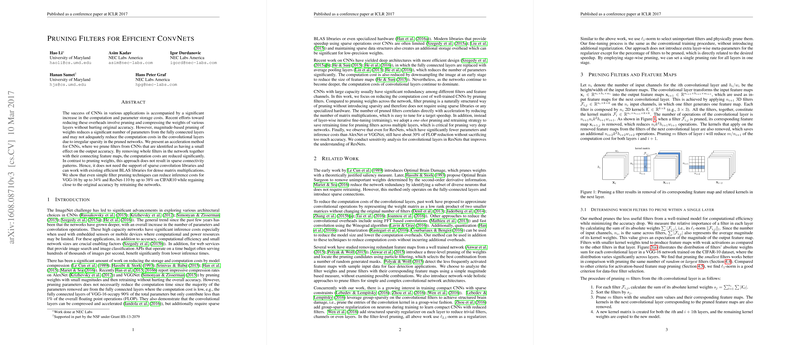Pruning Filters for Efficient ConvNets
Introduction
The paper "Pruning Filters for Efficient ConvNets" addresses the significant computational and storage costs associated with convolutional neural networks (CNNs), which have grown more complex and voluminous over time. The primary objective is to provide a method to prune entire filters from CNNs, thus reducing computational overhead without severely impacting the accuracy. This work presents a structured pruning approach that avoids the irregular sparsity patterns associated with magnitude-based weight pruning.
Methodology
The proposed method focuses on reducing the number of filters in the convolutional layers rather than pruning individual weights. By removing entire filters and their corresponding feature maps, the computational costs can be reduced more straightforwardly. This approach leverages existing efficient BLAS libraries for dense matrix operations, avoiding the need for specialized sparse convolution libraries.
The process involves calculating the -norm of each filter's weights to determine their relative importance. Filters with smaller -norms, which are expected to produce weak activations, are pruned. This strategy allows for a balanced reduction in computational load without the need for sparse data structures. The method is applied to different models, including VGG-16 on CIFAR-10 and ResNet variants on CIFAR-10 and ImageNet.
Results
The empirical results demonstrate that the proposed filter pruning method can achieve significant reductions in FLOP—up to 34% for VGG-16 and up to 38.6% for ResNet-110—while maintaining accuracy levels close to the original models. For example, VGG-16 on CIFAR-10 retains its performance with only a 0.15% drop in accuracy after a 34.2% reduction in FLOP. Similarly, ResNet-110 shows a minimal drop in accuracy with a substantial FLOP reduction.
The paper also highlights the relative sensitivity of different layers to pruning. Layers closer to the input and output are generally more sensitive, necessitating a careful selection of pruning rates. Additionally, the method's effectiveness was validated against other pruning criteria, such as activation-based feature map pruning, using criteria including mean-std and variance-based measures.
Implications
The practical implications of this research are significant, particularly for deploying CNNs in resource-constrained environments like mobile devices and embedded systems. The reduction in computational costs can lead to more efficient real-time applications and lower energy consumption.
Theoretically, this work contributes to understanding the inherent redundancies in deep networks and provides a structured approach to reducing these redundancies. This method could also be integrated with other model compression techniques like quantization and binarization to further enhance efficiency.
Future Directions
Future research could explore automated methods for determining optimal pruning rates across different layers and network architectures. Additionally, the approach could be extended to other neural network architectures beyond CNNs, such as recurrent neural networks (RNNs) or transformers.
Moreover, combining filter pruning with other techniques like network distillation and low-rank approximations could yield even more compact and efficient models. Investigating the impact of different regularization techniques during training to facilitate easier pruning could also be a fruitful area of paper.
Conclusion
The paper "Pruning Filters for Efficient ConvNets" presents a structured and effective method for reducing the computational demands of CNNs by pruning entire filters. This approach avoids the complexities associated with sparse operations and demonstrates significant FLOP reductions with minimal impact on accuracy. The results underscore the potential for deploying compressed models in real-time applications, suggesting extensive future research directions to enhance neural network efficiency further.
